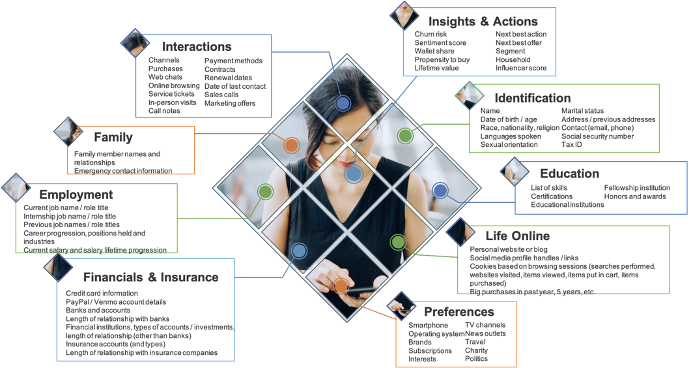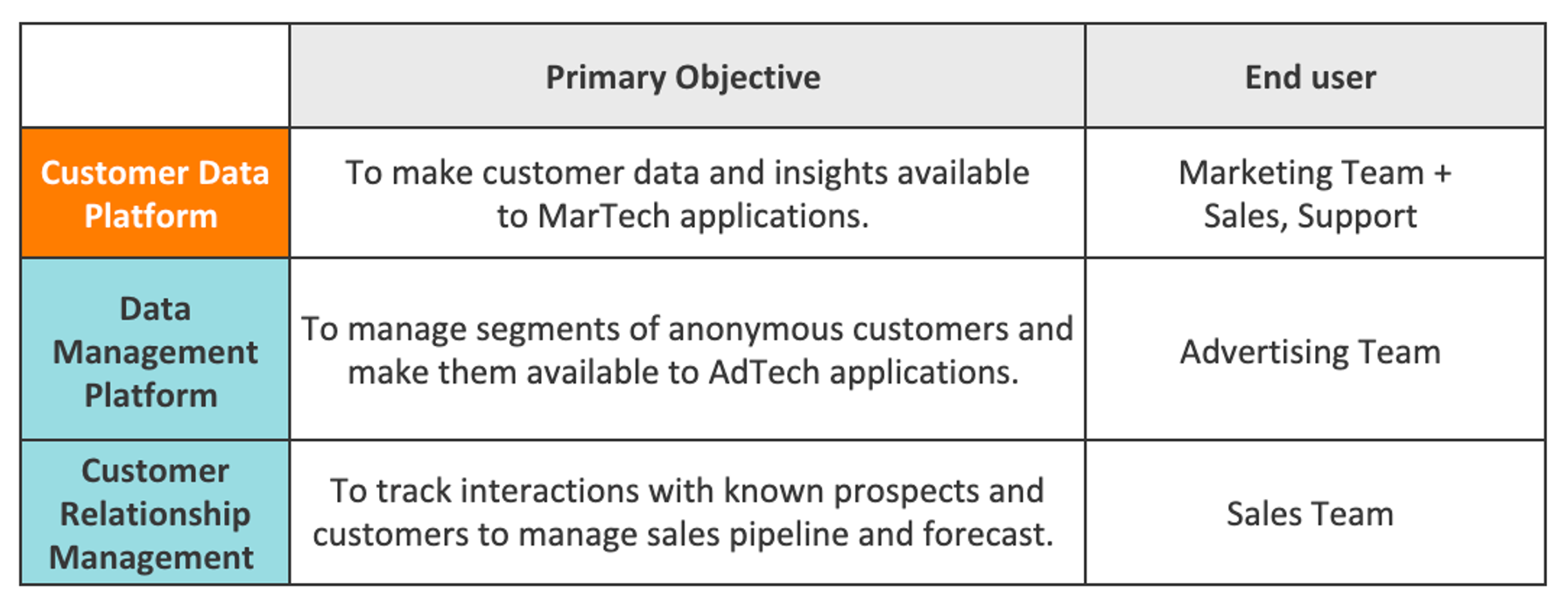Top Three Benefits of a Customer Data Platform for Excellence in Digital Commerce

Customer data platforms are relatively new solutions that were spearheaded by marketing’s need to better understand the customer. This need came about in large part due to the dramatic shift across all industries for more digital methods of doing business. Whether selling a shirt online, providing financial advice via mobile device, or buying real estate at a click of a button, digital has changed the way we live, buy, and do business.
Digital commerce is on the rise, growing at a rate of over 4% a year. Over 2.14 billion consumers shopped online in 2021, representing 1 in 4 people in the world. In addition, digital commerce is growing so quickly that it’s expected to make up a whopping 22% of retail sales worldwide by 2023.
With so many people shopping online, organizations are racing to transform their businesses to ensure buyers can find, research and purchase through their chosen device.
Digital commerce produces more data than traditional methods of shopping and interacting with brands. Brands can now have insight into browsing history, identify consumers earlier in the purchasing cycle and track purchases and behavior over time. This is applicable for both B2C and B2B organizations.
What is a customer data platform?
A customer data platform (CDP) is “packaged software that creates a persistent, unified customer database that is accessible to other systems,” according to the Customer Data Platform Institute (CDPI), a vendor-neutral organization dedicated to helping marketers manage customer data. In its simplest form, a customer data platform brings known and unknown customer data together into one view.
Customer data platforms centralize and standardize customer data and create contextually accurate and relevant customer profiles that are updated in real time as customers interact with your brand online or across any touchpoint. A customer data platform empowers users across marketing, sales and customer service/support with relevant, actionable customer insights to create longer-lasting relationships with your customers.
Customer data platforms:
- Ingest data from any source and help eliminate silos
- Capture full detail of ingested data
- Store data indefinitely (subject to privacy constraints)
- Create unified profiles of identified individuals and organizations
- Share data with any system or application that needs it
What is digital commerce?
According to Gartner, “Digital commerce enables customers to purchase goods and services through an interactive and self-service experience. It includes the people, processes, and technologies to execute the offering of development content, analytics, promotion, pricing, customer acquisition and retention, and customer experience at all touchpoints throughout the customer buying journey.”
To compete in today’s global economy, companies in nearly every industry must offer a way to shop and buy products and services online. There are several advantages of a digital commerce strategy:
- Increased control over brand message and consumer engagement
- More opportunities to innovate
- Higher margins
- Stronger brand loyalty
- Expanded market opportunities
- Direct access to customers and their data
Data is critical to digital commerce…and it must be managed
As mentioned, digital commerce generates a lot of data and information about customers. But, what exactly makes customer data, customer data? Let’s look at the common types of customer data generated by digital commerce.
Customer data is information consumers leave behind as they interact with your business either online or offline. Information may come from website visits, ecommerce portals, mobile interactions or surveys. Customer data includes identity (name, demographics, account), descriptive (career, education, lifestyle), behavior (transactions, online activity), and qualitative (survey, sentiment) data elements. Here are some examples of customer data typically managed by a customer data platform.

Top 3 benefits of a customer data platform for digital commerce
A customer data platform offers multiple benefits for organizations engaging in digital commerce. Here are a few examples of how the capabilities of a customer data platform can help you gain more customers, retain the right customers, and optimize the customer experience.
Benefit #1: Gain more customers with targeted segmentation
A customer data platform helps you grow market share by connecting information to ensure the right prospects are being targeted at the right time through the right channel. With a contextual view of customer data, marketers can tailor digital offers that improve customer acquisition rates at a lower cost. Campaigns based on micro-targeted segments perform better and result in improved lead generation and conversion rates.
Segmentation is a key feature of a customer data platform and is used to identify a group of individuals or organizations to target for a specific marketing or sales campaign. In segmentation, data is filtered by various characteristics to identify the target audience.
For example, a retailer introducing a new digital shopping service for busy moms may want to filter their prospects by gender, age, and income level. The campaign messaging and offers can be customized for the specific audience, resulting in better conversion rates.
Customer data platform users can select from the wide variety of attributes associated with customer profiles when building out segmentation. Prospect or customer segments can be created in real time, saved, monitored, and shared with marketing automation and email tools to execute campaigns.
According to a survey by MailChimp, segmented campaigns result in significantly better email performance than non-segmented campaigns.

Benefit #2: Retain the right customers with personalization
With a better view of each individual customer or account, organizations can do more than simply sell a product or service online. They can build relationships that result in repeat business. A customer data platform helps to personalize digital experiences, which leads to increased basket size and profitability (share of wallet) while reducing abandoned shopping carts and browsing.
Personalization is key to delivering on your customer retention strategy. One of the biggest obstacles is inaccurate, incomplete, and untrustworthy data. Bad data can lead to personalization going wrong, which can negatively impact customer experience and even lead to churn. A customer data platform improves data and insights, so that personalization efforts are more accurate and effective.
A customer data platform connects data from multiples sources by automatically identifying data about known and unknown customers, prospects, and accounts often across many digital channels. Data is linked to customer profiles, enabling marketers the ability to personalize at an individual level. Clean and trustworthy data powers multi-channel campaigns, personalized offers, and overall better customer experiences.
- 91% of consumers say they are more likely to shop with brands that provide offers and recommendations that are relevant to them. (Accenture)
- 63% of consumers will stop buying from brands that use poor personalization tactics. (Smart Insights)
- 83% of consumers are willing to share their data to create a more a personalized experience. (Accenture)
Benefit #3: Optimize customer experiences with next-best action
As we have said, data is key to creating brilliant customer experiences, especially with digital channels. Customer data platforms can identify next best action or offer or even understand when to not engage with a customer online due to an unresolved issue or negative review. Being able to personalize interactions results in improved customer satisfaction, retention and loyalty.
Customer data platforms enable next-best action or, as it is often referred to, next-best offer, through analytic capabilities often powered by predictive analytics and artificial intelligence (AI).
Based on the complete view of the customer stored within the customer data platform, potential actions can be identified and surfaced to marketers or sellers. These actions may be based on behavior analysis, inferred insights, and purchase or channels patterns. With real-time capabilities, next-best action algorithms can determine the right offer to send to the right customer at the right time via the right channel. This greatly increases the likelihood that the customer will purchase more from your brand and have a better overall experience.
Next-best action is also critical for knowing when not to make an offer to a customer or account in business-to-business (B2B) scenarios.
Consider you are a B2B software provider, and you have an account going through an upgrade that has experienced service disruptions. A customer data platform that manages B2B account data would also include service information on the account profile. This would ensure marketing has an up-to-date understanding of the account status and can identify that delivering a cross-sell or up-sell offer at this time could potentially result in a poor customer experience. Marketing could send educational information instead of an offer and wait until the upgrade is successfully completed before providing other offers to that account.
Customer data platforms beyond marketing
Many organizations have a vision of customer-centricity that puts the customer in the center of everything they do. This means that every department and employee think customer first. Executives and leaders across your organization have a stake in getting digital commerce right and they rely on well-managed data to deliver better customer experiences and business results.
- Marketing teams – Benefit from a unified view of the customer to support omnichannel personalization
- Ecommerce managers – Gain a cross-channel view of customer activity, on- and off-line
- Data scientists – Consume data from the customer data platform and look for patterns, trends and insights that drive process improvements and operational changes
- Customer service and support managers – Gain deeper insight into known and unknown customers and have visibility at the point of interaction
Customer data platforms differ from other digital commerce tools
Marketers have been using tools like customer relationship management (CRM) and data management platforms (DMP) for years. Although at times it might be difficult to distinguish between these solutions and a customer data platform, they do serve different purposes and have different fundamental capabilities.
At the most basic level, let’s look at the primary user of each solution. Customer relationship management is a sales-owned and sales-led tool that allows manual entry and tracking of customer interactions. Data management platforms are used for building advertising audiences.
Customer data platforms, as we have stated, are owned and used by marketing teams to better understand and identify customers, so marketing interactions can be more personalized, targeted and authentic.

Start driving excellence in digital commerce today
Data generated through digital commerce activity must be managed, integrated, and analyzed to uniquely identify consumers, so you can improve marketing outreach and personalization and deliver better overall digital experiences.
Interested in learning more about customer data platforms (CDPs)? Check out our on-demand webinar here.








